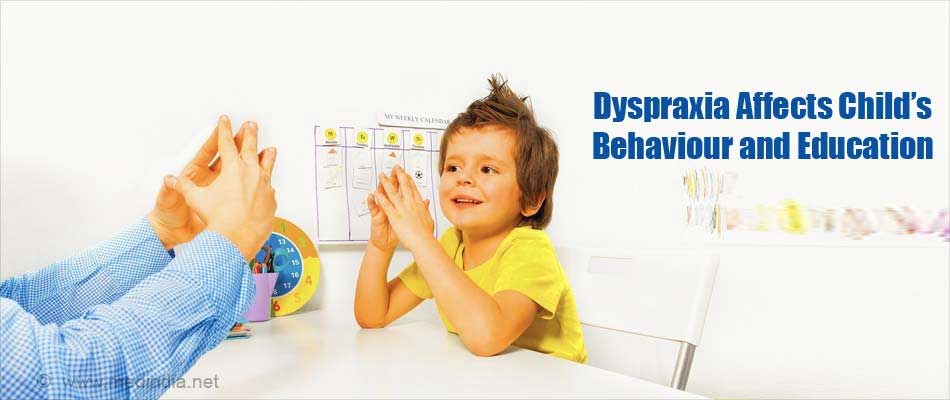- Dyspraxia - (https://www.healthdirect.gov.au/dyspraxia)
- 1 in 10 Odds are you know someone with Dyspraxia. - (http://www.dyspraxiausa.org/)
What is Dyspraxia?
Dyspraxia is a developmental disorder of the brain that is characterized by difficulty in controlling the muscles. It is a lifelong condition.
Dyspraxia is derived from two words “dys” (denoting difficulty) and “praxis” (denoting difficulty in movement). Dyspraxia leads to problems with coordination of gross movements (for example, kicking a ball), coordination of fine movements (for example, holding a spoon), speech and language. It affects the patient’s ability to perform a wide range of routine tasks.
Dyspraxia affects about 6-10% of all children, but the prevalence rate of dyspraxia is greater than this, as many children with symptoms have never been officially diagnosed. It is four times more common in boys than girls. There are many adults who have been diagnosed with dyspraxia later in life as their symptoms went unnoticed during their childhood.
Among famous personalities who have publicly stated that they have been diagnosed with this disorder is Daniel Radcliffe (actor who played Harry Potter).
What are the Causes of Dyspraxia?
In majority of patients, the cause is unknown. Recent research suggests that dyspraxia is due to disruption of the pathways that convey signals/messages from the brain to the muscles.
Risk factors for dyspraxia include:
Children, who were born prematurely, or had low birth weight Children, who were born to mothers with smoking, drug (such as cocaine or methamphetamine) or alcohol addictions.
What are the Different types of Dyspraxia?
- Ideomotor dyspraxia: The child is aware of simple one step tasks but has trouble to turn this knowledge into complex tasks. For example, he may be aware of all the steps required to brush his teeth, but is actually physically not able to perform the task of brushing.
- Ideational dyspraxia: The child finds actions that require planning or sequencing to be tough.
- Verbal dyspraxia or oromotor dyspraxia: The child has trouble in pronouncing words clearly due to movement impairment of oral muscles and tongue.
- Constructional dyspraxia: The child has problems with spatial awareness; he is unable to arrange objects in a pattern or to copy a drawing.
- Gait dyspraxia: The child’s walking is affected.
- Dressing dyspraxia: There is inability to dress correctly due to impairment in sensing the correct orientation and sequence of clothes.
What are the Symptoms of Dyspraxia?
Dyspraxia can affect kids differently; some are more severely affected than others. Usually, symptoms appear quite early in life, when the child is still a baby. As the child grows, a few symptoms may improve.
Symptoms in babies:
The baby could be unusually irritable, crying incessantly and may have feeding issues. The parent may notice that the baby is slow in reaching milestones, such as rolling over, crawling, walking or talking.
Symptoms in the toddler age group:
The child may not be able to hold a spoon properly; hence he may prefer to eat with his fingers/hand. He may drop food and usually is termed as a messy eater. He may avoid playing with construction toys, blocks or puzzles and has trouble in riding his tricycle. He may trip frequently while walking or running. It is difficult to toilet train the child. His speech is poor when compared to other children of his age.
Symptoms in 3-5 years old child:
The child bumps into objects frequently. He finds it difficult to hop, skip or jump. The child may not be able to hold objects, thereby dropping them in the process and finds it tough to tie his shoe laces, or brush his teeth. As he finds it problematic to hold a pencil correctly, he is unable to write or draw properly. He finds it tough to work buttons or zippers of his clothes/bags. He may speak very slowly, or may speak at a higher or a lower pitch. The child is unable to interact and play with other kids.

Symptoms in a preteenager:
The child may take a long time to write due to problems in holding the pencil/pen. Similarly he faces problems typing on a keyboard or using a scissors. He finds it difficult to play games that require hand to eye coordination such as chess and board games. He may have trouble in following and remembering instructions. Problems with visual perception lead to poor copying and reading skills. He may also show spatial perception difficulties (for example, he cannot differentiate between front and back or left and right). He may take a long time to answer even though he is aware of the answer. He may be termed as having poor mathematical skills (for example, unable to line up numbers or draw geometrical figures). He may also find it difficult to stand for a long time due to weak muscle tone. He starts avoiding games, sports and physical activities at school.
Symptoms in teenagers:
He finds it difficult to play sports that involve jumping or cycling. He may forget the instructions of his teacher. He may be unable to structure and organise his thoughts while writing assignments. He may talk continuously along with repetition and finds it tough to pick up non-verbal signs of communication.
Symptoms in adults:
Most of the above mentioned symptoms continue into adult age. The patient may find it difficult to learn new skills at home, college or workplace.
How does Dyspraxia Affect the General Wellbeing of a Patient?
- It is evident that dyspraxia affects a child’s education, behaviour, communication and development of skills like self-care which are needed for independent functioning.
- Difficulties in reading, writing, mathematics and spelling lead to poor academic grades of the child.
- A child with speech problems finds it difficult to interact with other children and to make friends.
- Movement and speech difficulties may result in the child refusing to participate in extracurricular activities like games, sports, dancing, debates among other activities.

- As they are unable to connect emotionally and socially with other people, this can impact their social interaction at school or at work and may lead to low self-esteem and anxiety issues.
- They are found to lag behind in age appropriate skills. For example, a 10 year old may still find it difficult to brush his teeth or button his shirt. An 18 year old may find difficult to drive a car or learn basics of cooking. Adults may find it difficult to gain meaningful employment and to function independently.
- As dyspraxic patients also experience problems with memory, perception and processing of information, they find it difficult to plan, organize and execute their activities. This affects their performance at school, university or at their workplace.
All these can have negative impact on daily life.
How do you Diagnose Dyspraxia?
Although a child may show symptoms early on, dyspraxia is diagnosed around 5 years of age. Parents are encouraged to observe their child’s milestones and behaviour and to consult a doctor if they have witnessed any warning symptoms. Usually parents describe the child as being clumsy and messy.
The symptoms have to be present for at least 6 months before the child can be termed as having dyspraxia. The assessment of the child is carried out by a multidisciplinary team that includes a neurologist, pediatrician, speech and language therapist, an occupational therapist and a physical therapist.
The child is usually asked to perform various activities depending on the history mentioned by the parents/caregivers and the type of dyspraxia that is suspected. The doctor performs a full neurological examination. Various screening tools and checklists are available to help the health care team in reaching a diagnosis such as Developmental Coordination Disorder Questionnaire (DCDQ) for 5-15 year old children, The Adult Developmental Coordination Disorder/ Dyspraxia Checklist (ADC) for adults and so on. Investigations like blood tests and CT/MRI scanning of the brain are performed to rule out other neurological conditions having similar symptoms.
What is the Treatment for Dyspraxia?
There is no cure for dyspraxia. As dyspraxia can sometimes co-exist with ADHD, the doctor may prescribe medications for ADHD that would enable the patient to focus when working along with an occupational or speech therapist.
Although dyspraxia is not curable, with treatment the symptoms can improve. The sooner the child is started on therapy; the better will be their prognosis.
Management of dyspraxia focuses on developing strategies for the patient to be able to cope up with day to day functions.
Occupational therapy: Occupational therapy can help improve the patient’s balance and coordination. An occupational therapist first evaluates the patient to assess for movements that cause trouble (for example, a child may not be able to button his shirt). The therapist then breaks down these complex skills into stepwise and easy to follow motor tasks, so that the patient is able to practice them. With constant practice the patient becomes more skilled at carrying out these tasks.
Speech therapy: Speech therapy helps if the patient is unable to pronounce words correctly. The speech therapist focuses on movement of the mouth and tongue to make certain words. It also helps the patient to make his voice louder or softer by teaches him to control his breathing.
Hippotherapy: Hippotherapy refers to horse riding for improving co-ordination. Here, as the patient rides a horse, the therapist uses the natural movements of the horse to help the patient improve his physical skills like balance and coordination.
Perceptual motor training: Here, a therapist first provides visual and auditory commands to the child and then integrates these commands with the child’s movement using specific exercises.
Active play: Any play either indoors or outdoors that involves physical activity can help to improve the child’s motor skills.
An educational psychologist can identify the academic and social inadequacies of the child and can devise steps to minimise these problems.

How do you Prevent Dyspraxia?
Dyspraxia can be prevented to a certain extent if the pregnant woman does not smoke, does not take recreational drugs or consume alcohol during pregnancy. She is advised to eat a healthy well balanced diet to prevent low birth weight of the baby.
Tips to Help Dyspraxic Patients
- Speak slowly, clearly and use short sentences when speaking to a dyspraxic patient, repeat the instructions if necessary.
- Positive reinforcement is extremely effective, praise the child when he successfully completes a task.
- Assistive technology such as dictation software and touch screens can help the child at school. At home the patients may use electric razors, electric toothbrush, kettle tippers and so on to help with their daily chores.
- The patient is encouraged to use diaries or calendars to organize his daily events. He is advised to finish one task before starting another.






